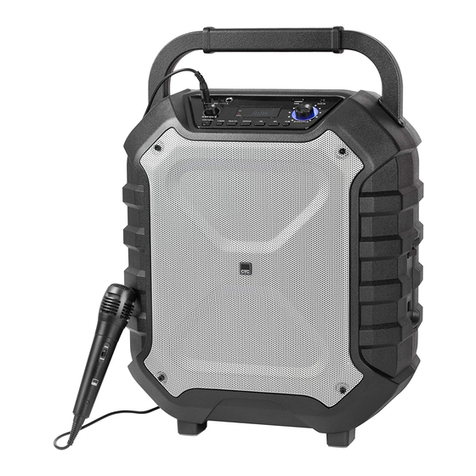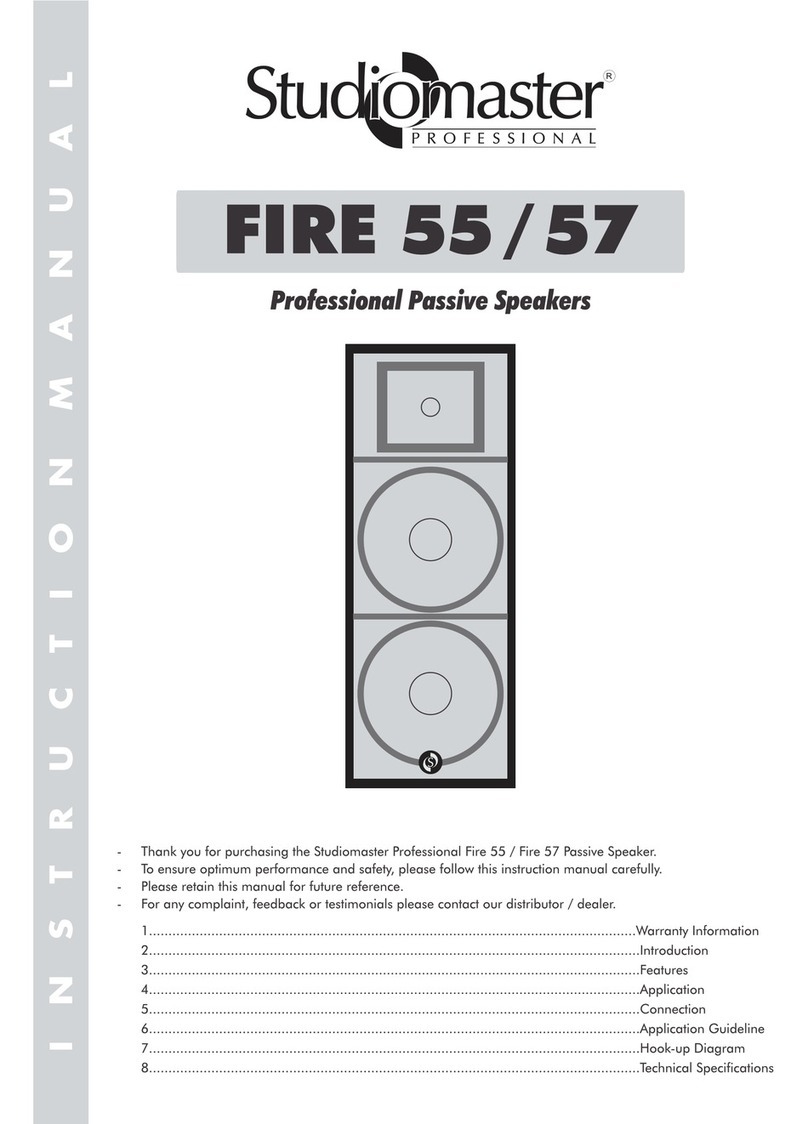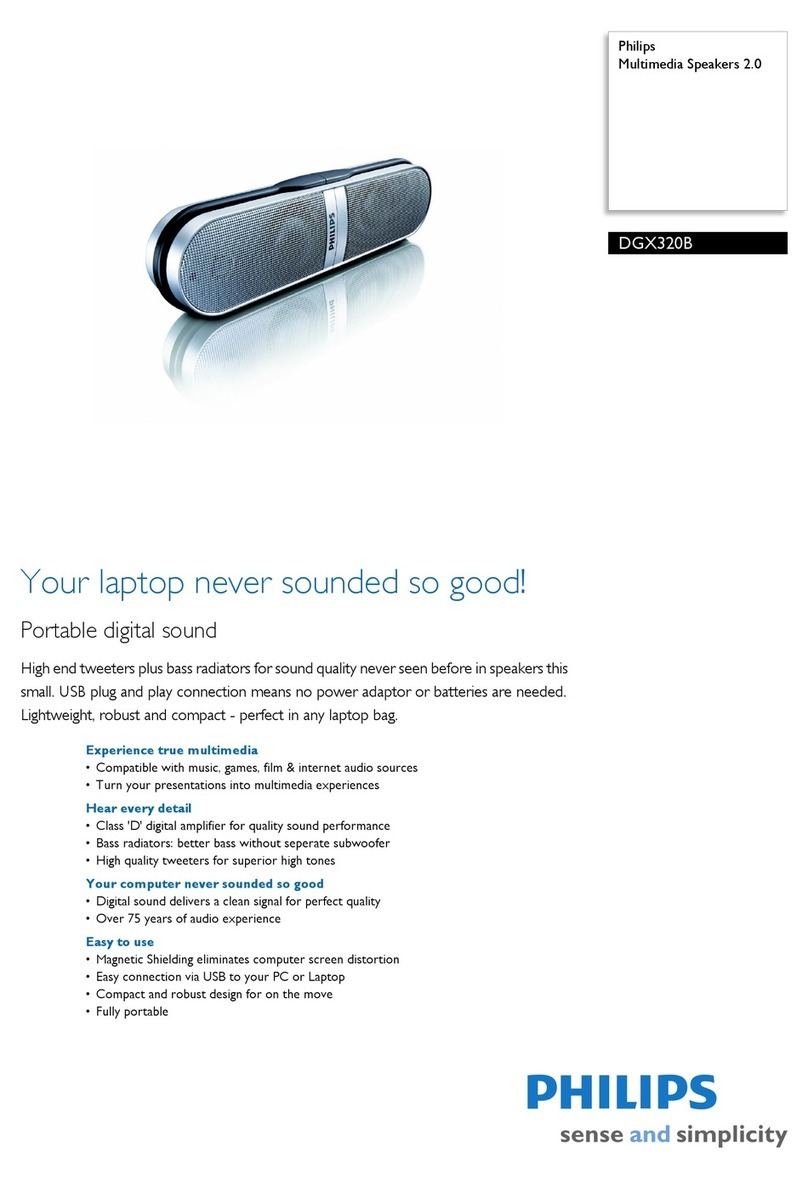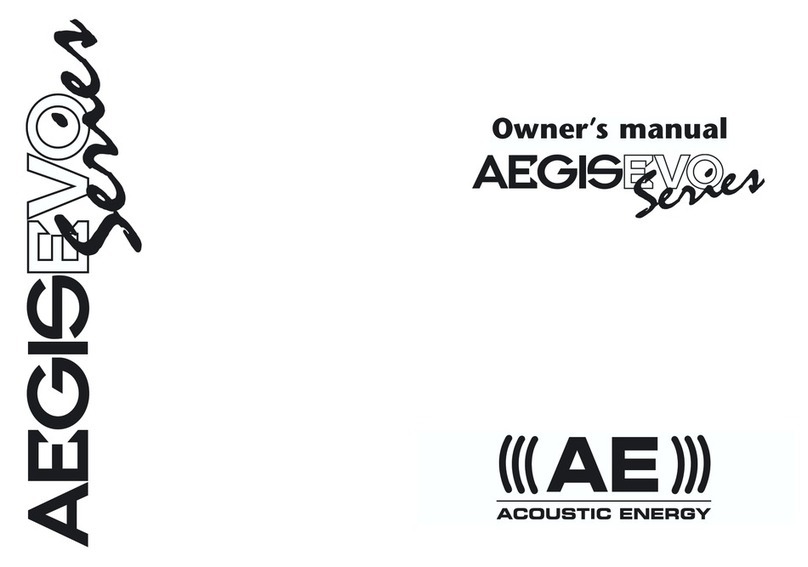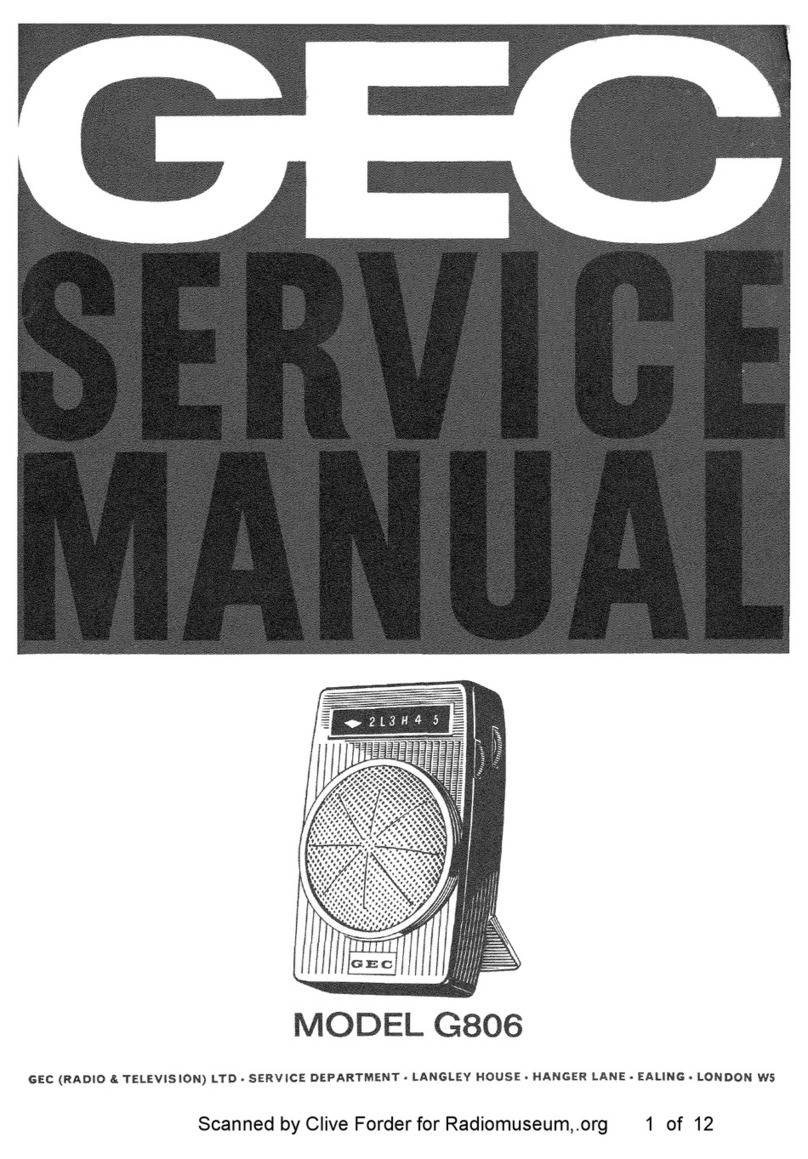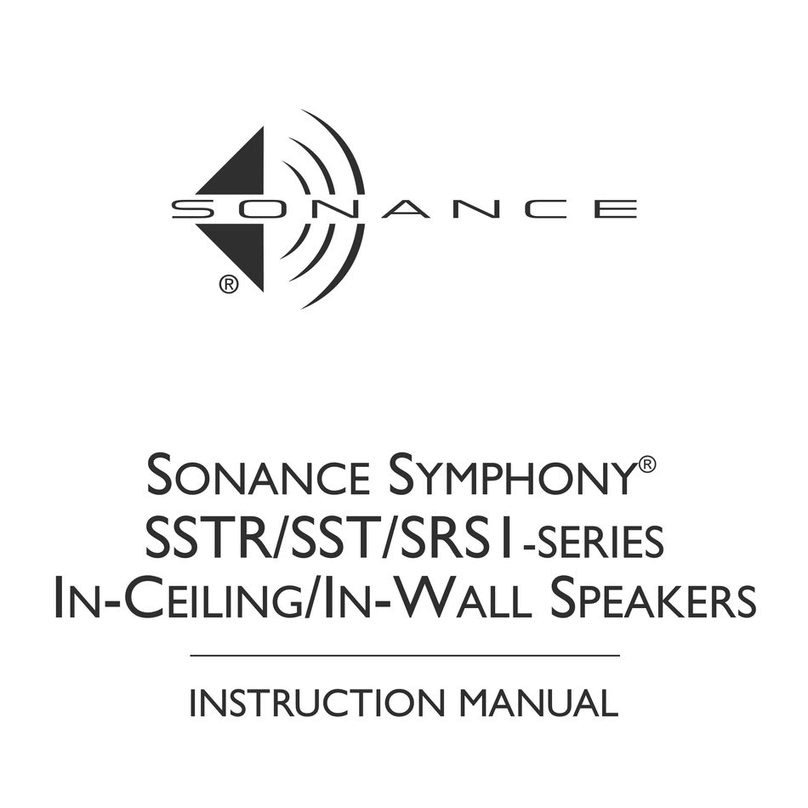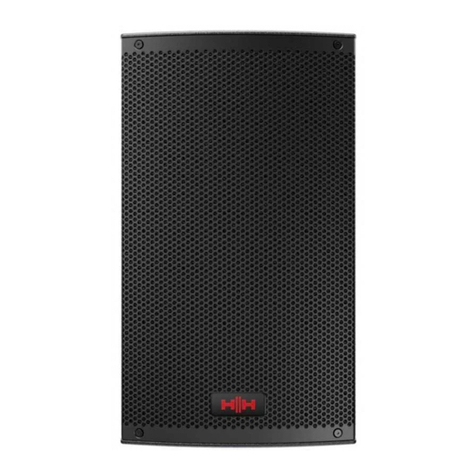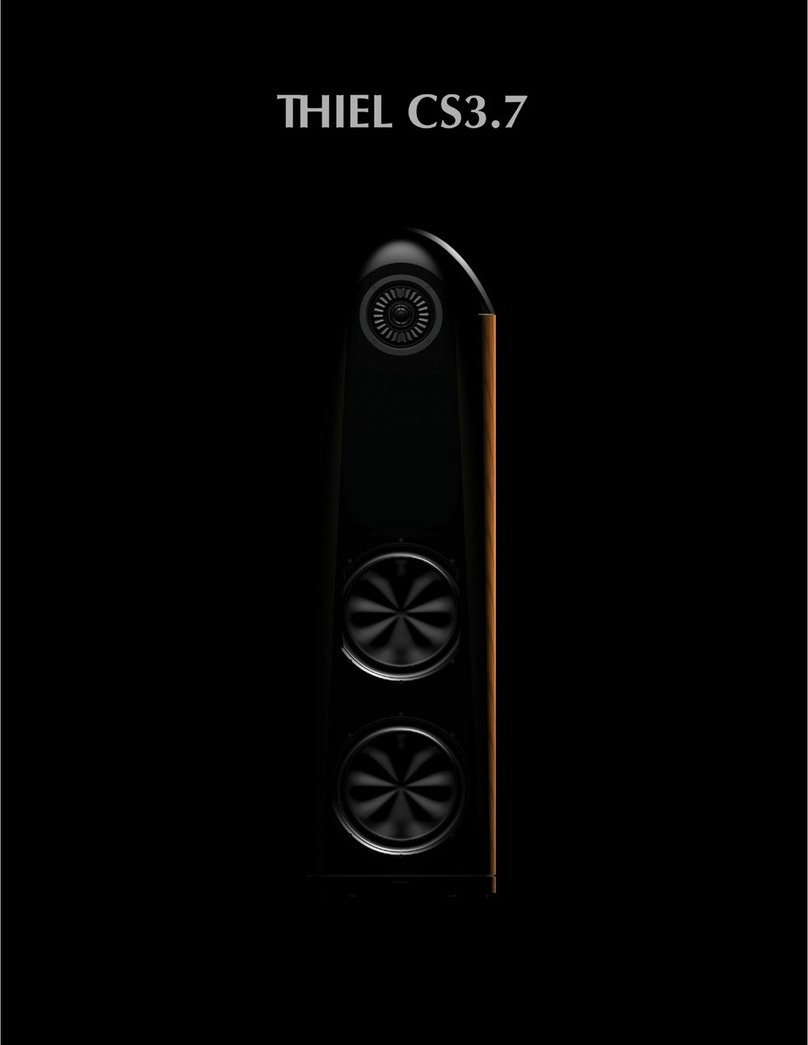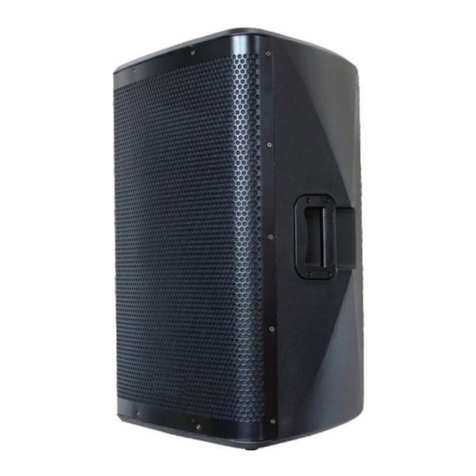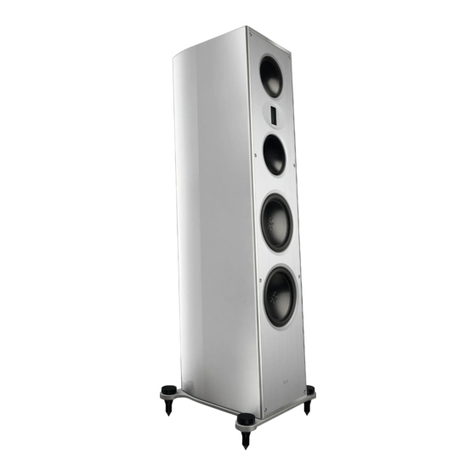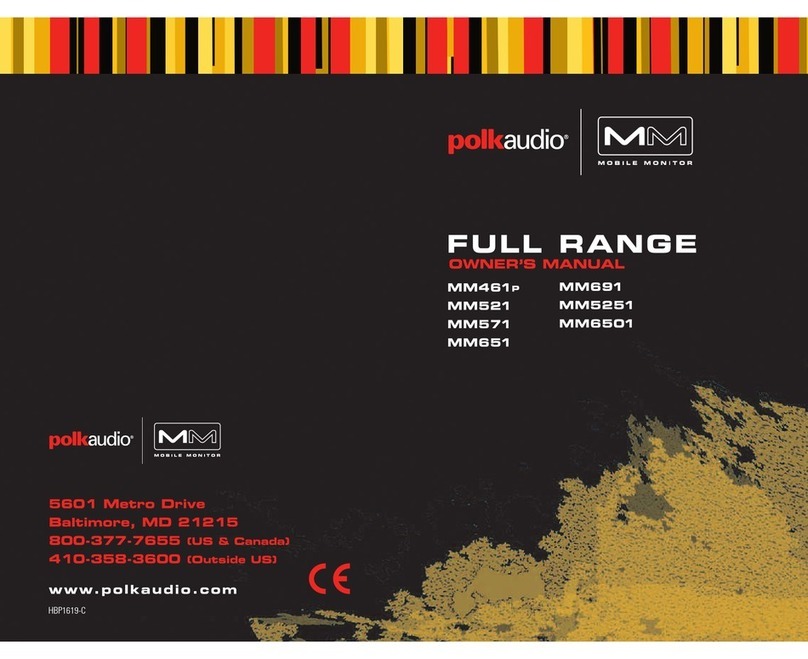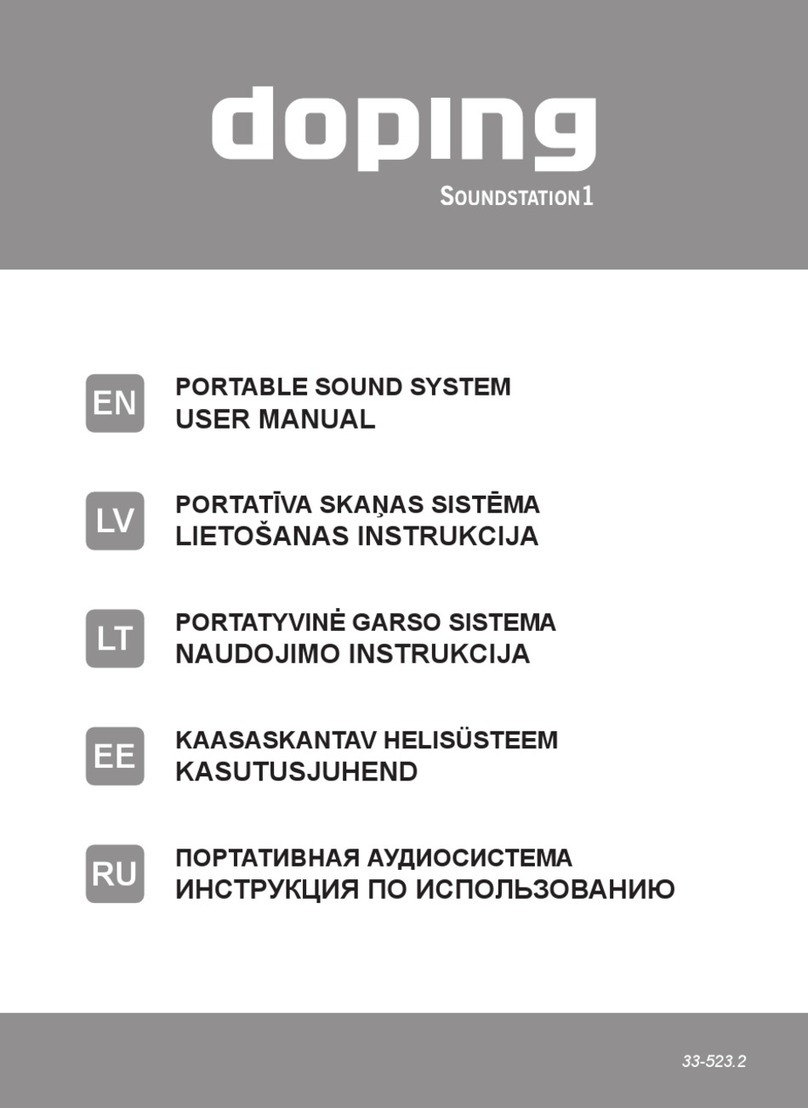Eve Audio ThunderStorm TS110 User manual

EVE AUDIO PRODUCT MANUAL
TS110
TS112
NOV 2015

TS110
TS112
2
SAFETY INSTRUCTIONS
1. READ these instructions.
2. KEEP these instructions.
3. HEED all warnings.
4. FOLLOW all instructions.
5. DO NOT use this apparatus near water.
6. CLEAN ONLY with dry cloth.
7. DO NOT block any ventilation openings. Install in accordance with the
manufacturer’s instructions.
8. DO NOT install near any heat sources such as radiators, heat registers,
stoves, or other apparatus (including ampliers) that produce heat.
9. DO NOT defeat the safety purpose of the polarized or grounding-type
plug. A polarized plug has two blades with one wider than the other. A
grounding type plug has two blades and a third grounding prong. The
wider blade or the third prong are provided for your safety. If the provided
plug does not t into your outlet, consult an electrician for replacement of
the obsolete outlet.
10. PROTECT the power cord from being walked on or pinched particularly at
plugs, convenience receptacles, and the point where they exit from the
apparatus.
11. ONLY USE attachments/accessories specied by the manufacturer.
12. USE ONLY with the cart, stand, tripod, bracket, or table specied by the
manufacturer, or sold with the apparatus. When a cart is used, use caution
when moving the cart/apparatus combination to avoid injury from tip-
over.
13. UNPLUG this apparatus during lightning storms or when unused for long
periods of time.
14. REFER all servicing to qualied service personnel. Servicing is required
when the apparatus has been damaged in any way, such as power-supply
cord or plug is damaged, liquid has been spilled or objects have fallen into
the apparatus, the apparatus has been exposed to rain or moisture, does
not operate normally, or has been dropped.

EVE Audio product manual
3
15. To reduce the risk of re or electric shock, do not expose this apparatus
to rain or moisture. The apparatus shall not be exposed to dripping or
splashing and that objects lled with liquids, such as vases, shall not be
placed on apparatus.
16. Where the MAINS plug or an appliance coupler is used as the disconnect
device, the disconnect device shall remain readily operable.
17. DO NOT overload wall outlets or extension cords beyond their rated
capacity as this can cause electric shock or re.
18. No naked ame sources, such as lighted candles, should be placed on the
apparatus.
19. Minimum distances around the apparatus for sucient ventilation.
20. The ventilation should not be impeded by covering the ventilation
openings with items, such as newspapers, table cloths, curtains, etc.
21. Correct Disposal of this product. This marking indicates that this
product should not be disposed with other household wastes
throughout the EU. To prevent possible harm to the environment
or human health from uncontrolled waste disposal, recycle it
responsibly to promote the sustainable reuse of material resources. To
return your used device, please use the return and collection systems or
contact the retailer where the product was purchased. They can take this
product for environmental safe recycling.
22. The lightning ash with arrowhead symbol within an equilateral
triangle is intended to alert the user to the presence of uninsulated
“dangerous voltage” within the product’ s enclosure that may be
of sucient magnitude to constitute a risk of electrical shock to persons.
23.
!
The exclamation point, within an equilateral triangle, is intended
to alert the user to the presence of important operating and
maintenance (servicing) instructions in the literature
accompanying the product.
24.
RISK OF ELECTRIC SHOCK.
DO NOT OPEN.
CAUTION
AVIS : RISQUE DE CHOC ÉLECTRIQUE – NE PAS OUVRIR.
WARNING: Do Not Open! Risk of
Electrical Shock. Voltages in this
equipment are hazardous to
life. No user-serviceable parts
inside. Refer all servicing to qualied service personnel. Place the
equipment near a main power supply outlet and make sure that you can
easily access the power breaker switch.

TS110
TS112
4
25. WARNING: This product is intended to be operated ONLY from the AC
Voltages listed on the back panel or included power supply of the product.
Operation from other voltages other than those indicated may cause
irreversible damage to the product and void the products warranty. The
use of AC Plug Adapters is cautioned because it can allow the product
to be plugged into voltages in which the product was not designed to
operate. If the product is equipped with a detachable power cord, use only
the type provided with your product or by your local distributor and/or
retailer. If you are unsure of the correct operational voltage, please contact
your local distributor and/or retailer.

EVE Audio product manual
5
TABLE OF CONTENT
1. INTRODUCTION ............................................................................6
2. QUICK START.................................................................................7
2.1. First Steps.............................................................................................................................7
2.2. Subwoofer Connection...................................................................................................7
2.3. Powering On .......................................................................................................................7
3. OPERATION ...................................................................................8
3.1. First Steps.............................................................................................................................8
3.2. Operating Modes ..............................................................................................................9
3.3. Powering on/o: Standby Mode .................................................................................9
3.4. Volume Mode .....................................................................................................................9
3.5. Settings Menu ................................................................................................................. 11
3.6. Filter .................................................................................................................................... 11
3.7. Sat. Filter............................................................................................................................ 11
3.8. Sub Filter ........................................................................................................................... 12
3.9. Sub Phase.......................................................................................................................... 12
3.10. LED Mode.......................................................................................................................... 12
3.11. Saving Your Settings ..................................................................................................... 13
3.12. Remote Control............................................................................................................... 13
3.13. Power Switch ................................................................................................................... 14
3.14. DIP Switches..................................................................................................................... 15
3.15. Mains Voltage Selector................................................................................................. 15
3.16. Power Connector (IEC) ................................................................................................. 15
4. POSITIONING ..............................................................................17
4.1. Subwoofer Positioning................................................................................................. 17
4.2. Height and Distance ..................................................................................................... 17
4.3. Stereo Setup + Subwoofer (2.1)................................................................................ 18
4.4. Multichannel Setup (5.1) ............................................................................................. 19
4.5. Room Acoustics .............................................................................................................. 20
5. TECHNICAL SPECIFICATIONS .....................................................21
6. COMPLIANCE...............................................................................22
7. WARRANTY..................................................................................23

TS110
TS112
6INTRODUCTION
1. INTRODUCTION
Thank you for your time and interest in the EVE Audio product range.
EVE Audio is a loudspeaker manufacturer based in Berlin, Germany, that
specializes in the development and design of unique studio monitors.
The use of rst-class components is our highest priority because we rmly
believe this is the only way to manufacture rst-class products.
You have chosen a TS110 or TS112 subwoofer from our ThunderStorm
series. Both modelsmake use of passive radiators instead of a bass reex
port. This allows for a lower tuning of the subwoofer and avoids the
emergence of hum, which is unavoidable when applying the bass reex
port design. The passive radiator is on the bottom side of the subwoofer.
The subwoofers of the ThunderStorm series are the ideal extension for the
two, three and four-way systems of the EVE Audio SilverCone series. They
can be easily integrated in any situation thanks to their ThunderStorm
Chassis (10” or 12”), PWM ampliers (250 and 400 Watt), accurate DSP
technology and IR remote control.
We wish you a lot of fun with your EVE Audio subwoofer. If you have any
questions regarding our products, do not hesitate to contact your nearest
dealer or get directly in touch with us... We will be more than happy to help
you out!
All the best from Berlin.
The EVE Audio Team

EVE Audio product manual
Powering On
7
QUICK START
2. QUICK START
If you already have experience with studio subwoofers, the Quick Start
guide ought to be more than enough to get you started.
For unexperienced users we recommend reading the whole user’s manual
in order to prevent any misuse.
2.1. First Steps
Check the package components (loudspeaker, remote control + batteries,
user’s manual, power cord).
Check the voltage setting (see “Mains Voltage Selector”).
Check the setting of the DIP Switches (variable).
2.2. Subwoofer Connection
Connect the two inputs on the rear side (L In + R In) to the left and right XLR
outputs of a playback source, for instance, an audio interface. The output
level should be as low as possible.
Connect the two outputs on the rear side (L Out + R Out) to the
corresponding XLR inputs of your studio’s left and right satellites. All
output levels should be as low as possible.
2.3. Powering On
Engage the Power switch on the rear side of the subwoofer to turn it on
or o.
The LEDs around the System Volume control on the front panel will light
up clockwise. If the LED on the right end is dimly lit, this indicates that the
subwoofer is in Standby mode. Press the System Volume control to turn
the subwoofer on. If you turn the System Volume control counter clockwise
until the LED on the left end lights up dimly the subwoofer will be muted.
Increase the output level on the source device until the LED ring starts to
blink, then reduce the output level a bit. The maximum operating level
for the input (i.e. the analog to digital converter) is now set optimally. To
set the desired listening volume use the System Volume control on the
subwoofer. The LED ring indicates the volume setting. If the LED ring starts
to blink, reduce the output level on the signal source.

TS110
TS112
First Steps
8OPERATION
3. OPERATION
3.1. First Steps
Rear Connections & DIP Switches
Check the package components (loudspeaker, remote control + batteries,
user’s manual, power cord).
Check the voltage setting (see “Mains Voltage Selector”).
Check the setting of the DIP Switches (variable).
Connections: there are XLR input and output connectors on the rear side
that allow the connection of balanced and unbalanced devices (signal
sources, active monitors, etc.).
•Balanced XLR pin assignment XLR: 1= Shield, 2= hot (+), 3= cold(-).
•Unbalanced XLR pin assignment XLR: 1+3= Shield, 2= Signal.
Depending on the setting of the Max. Input DIP switch on the rear panel,
the maximum level of the source signal should not exceed +7 dBu or +22
dBu (see Max. Input). If the input is overloaded the LED ring will start
blinking.

EVE Audio product manual
Volume Mode
9
OPERATION
3.2. Operating Modes
Standby mode | Volume mode (-10dB) | Settings menu (Sub Filter @ 100 Hz)
3.3. Powering on/off: Standby Mode
Press and hold the System Volume control three seconds in order to put the
subwoofer in Standby mode. The total volume (subwoofer + satellites) will
decrease gradually while the LED ring lights up once around the System
Volume control. Afterwards, the LED on the right end will remain dimly lit
and the power consumption is reduced to 1 watt.
!To exit the Standby mode press briey the System Volume control once
again. The level will increase gradually until it reaches the previously
selected volume.
3.4. Volume Mode
•Level Adjustment
The maximum input level for balanced and unbalanced signals is +7dBu
or +22 dBu, depending on the position of the Max. Input switch on the rear
panel (see DIP Switches). Higher levels at the input produce distortion due
to the overloading of the analog to digital converter.
Given that some professional studio devices can produce in excess of
+22 dBu, the LED ring will start blinking whenever the AD converter is
overloading. Generally speaking, the +7dBu setting ought to be suitable. If
that is the case, the output level of the source should be reduced.
•Total Volume Adjustment
Turn the System Volume control to adjust the total volume (subwoofer
+ satellites). Depending on the LED mode selected (see LED mode), the
volume will be displayed as a dim/bright circle or as a dim/bright point.
•Subwoofer Volume Adjustment
Turn the Subwoofer Volume control to adjust the volume of the subwoofer
independently from the satellites. This allows you to strike the right
balance between subwoofer and satellites. The LED ring indicates the
volume setting.

TS110
TS112
Volume Mode
10 OPERATION
-80 dB 0 dB
-8 dB
-12 dB
-20 dB
-48 dB
1 Step = 2 dB
(1 LED = 4 Steps)
1 Step = 1 dB
(1 LED = 4 Steps)
1 Step = 0.5 dB
(1 LED = 4 Steps)
1 Step = 0.5 dB
(1 LED = 4 Steps)
1 Step = 0.5 dB
(1 LED = 2 Steps)
Both controls feature the exact same response curve, which is not linear.
The increments become ner as the volume increases:
-80dB (minimum) to -48dB: 2dB
-48dB to -20dB: 1dB
-20dB to 0dB (maximum): 0.5dB
•Subwoofer Mute
To Mute the subwoofer, press briey the Subwoofer Volume control. All
LEDs will turn o, except for the left-most LED, which lights up dimly.
!To exit the Subwoofer Mute mode press the Subwoofer Volume control
once again. The subwoofer will return to the volume level it had before
being muted.
•System Mute
To Mute the whole system (subwoofer + satellites), turn the System Volume
control counter clockwise until you reach the minimum level. When the
LED on the left end of the System Volume control lights up dimly the Mute
mode is activated.
!To exit the System Mute mode simply turn the System Volume control
clockwise until you reach the desired volume.

EVE Audio product manual
Sat. Filter
11
OPERATION
3.5. Settings Menu
Additional status LEDs on the front panel plus infrared sensor
Press the System Volume control once to enter the Settings menu. Here
you can set two dierent lters (Sat. Filter and Sub Filter), as well as the
phase of the subwoofer and the behavior of the volume controls’ LED
rings. The LED of the currently active function will blink.
Turn the System Volume control to choose the lter, phase or LED mode
desired. The blinking LED indicates the function selected, while the steady-
on LED indicates the value assigned to that function.
Press the System Volume control to conrm your selection. The blinking
will stop once the selection is conrmed.
Turn the System Volume control to adjust the lter, phase or LED behavior.
When you are satised with the setting press the System Volume control
again to go back to the Settings menu. You can then select and edit
another function.
!To exit the Settings menu press and hold the System Volume control for
three seconds or simply wait 10 seconds. The subwoofer will then return
automatically to the Volume mode.
3.6. Filter
The lters of the EVE Audio subwoofer were specially developed to oer
you the possibility of adjusting your subwoofer to the characteristics of
your system. These lters help control the overlapping of frequencies
between the subwoofer and the satellites. The goal is to optimize the
sound image to the room acoustics and to a given listening distance.
3.7. Sat. Filter
The Sat. Filter is a high-pass lter that can be used to lter out all content
below 80Hz from the L + R outputs going to the satellite speakers. Use this

TS110
TS112
LED Mode
12 OPERATION
lter to avoid the overlapping of frequencies between the subwoofer and
the satellites and to clean up the sound image in the lower end.
Generally speaking, the Sat. Filter should be engaged (default setting). If
inactive, for example, when the satellite speakers cannot reproduce the
frequency range below 80 Hz, the Sat Flat LED lights on and the audio
signal is not ltered.
3.8. Sub Filter
The Sub Filter is a low-pass lter that allows you to set the upper frequency
limit of the subwoofer. It can be set from 60 Hz up to 140Hz.We recommend
setting it at 80Hz, but do bear in mind that it might need to be adjusted
depending on the room and satellite speakers used.
In LFE mode the cuto frequency is set to 300Hz. The LFE LED indicates
when this lter is activated.
3.9. Sub Phase
This setting allows you to shift 180° the phase of the subwoofer signal. The
Sub Phase LED lights on.
Use this function when the overall sound (subwoofer + satellites) sounds
a bit thin. This can happen if the subwoofer’s phase is oset from the
satellites’due to time dierences.
3.10. LED Mode
The LED mode determines in which of the four available fashions the LED
rings display the volume level. The LEDs represent given levels, which are
displayed and adjusted according to four or two steps. Intermediate steps
are indicated by the brightness between two adjacent LEDs.
•Bright Ring
All LEDs up to the selected volume level light up brightly. The louder the
signal, the longer the brightly lit-up ring.
•Bright Point
Only the LEDs corresponding to the selected volume level light up brightly.
The louder the signal, the further up the brightly lit-up point moves.
•Dimly Lit Ring
All LEDs up to the selected volume level light up dimly. The louder the
signal, the longer the dimly lit-up ring. In this mode, the LEDs light up
brightly momentarily while you adjust the volume level.

EVE Audio product manual
Remote Control
13
OPERATION
•Dimly Lit Point
Only the LEDs corresponding to the selected volume level light up dimly.
The louder the signal, the further up the dimly lit-up point moves.
!Intermediate steps are indicated by the lighting of two adjacent LEDs. The
level ranges from -60 dB to +10 dB, taking “0 dB” as reference point.
3.11. Saving Your Settings
All settings on the front and rear panels are automatically saved. The
loudspeakers can be disconnected anytime without the settings being
lost.
3.12. Remote Control
Your EVE Audio subwoofer comes with an IR remote control that allows
you to control almost all functions available on the front panel.
In order to start using the remote control, you must rst insert the supplied
batteries in the battery compartment. Please pay attention to the polarity.
Hold the remote control in such a way that the infrared cell points towards
the receiver cell on the subwoofer. There should be no objects between
both cells in order to achieve the best performance.
•On Button
Use the On button to put the subwoofer in Standby mode (see Powering
On/o: Standy Mode). Press the button again to exit the Standby mode.
•LED Button
Use the LED button to select the LED mode of the subwoofer. The mode
changes every time you press the button (bright ring, bright point, dimly
lit ring, dimly lit point).
•Phase Button
Press the Phase button to shift 180° the phase of the subwoofer signal
(see Sub Phase). The Sub Phase LED on the subwoofer lights on. Press the
button again to return the phase to 0°.

TS110
TS112
Power Switch
14 OPERATION
•Pure Satellite Button
Use the Pure Satellite button to mute the subwoofer (Mute function: see
Subwoofer Mute) so that the audio signal is transmitted without any
ltering to the satellite speakers. This allows you to switch easily between
satellites + subwoofer mode and pure satellite mode (without subwoofer
and without any ltering).
•System Volume (+)/(-) Buttons
Use the System Volume (+) and (-) buttons to increase or decrease the total
volume (subwoofer + satellites).
•Sub Volume (+)/(-) Buttons
Use the Sub Volume (+) and (-) buttons to increase or decrease the
subwoofer volume, and thus balance the level between subwoofer +
satellites (see Subwoofer Volume Adjustment).
•Sub Filter (+)/(-) Buttons
Use the Sub Filter (+) and (-) buttons to set the cuto frequency of the
subwoofer’s low-pass lter and to select the LFE mode (see Sub Filter).
•Mute Button
Press the Mute button to mute the whole system (subwoofer + satellites)
(see System Mute). Press the button again to exit the Mute mode.
3.13. Power Switch
The power switch on the rear panel disconnects the subwoofer completely
from the power grid. When powered o all settings are saved and the
power consumption is reduced to 0 watts.
After powering on again, the subwoofer will return to the state it was in
before being turned o (Standby mode, Mute mode or a given volume
level). Even if powered o via a multiple outlet power strip, the subwoofer
will return to the state it was in before being turned o.
!In order to prevent switching noise with your monitoring system, keep in
mind the following rules:
Power all audio sources on rst, then the subwoofer and then the satellites.
When turning o your system, power o the satellites rst, then the
subwoofer and nally all audio sources.

EVE Audio product manual
Power Connector (IEC)
15
OPERATION
3.14. DIP Switches
On the rear panel of your EVE Audio subwoofers you will nd four DIP
Switches. These allow you to secure your subwoofer settings to prevent
them from being changed inadvertently.
•Filter
When set to “lock,” this DIP Switch secures the current lter settings. The
lter settings can be read on the LED ring of the System Volume control on
the front panel, but they cannot be modied. When set to “var,” the lters
can be modied freely.
•Volume
When set to“lock,”this DIP Switch secures the current volume settings. The
LED rings on the front panel indicate the volume settings of the subwoofer
and the satellites, but they cannot be modied. When set to “var,” the
volume setting can be changed by simply turning the knob.
•Not used
No Function.
•Max. Input
This DIP Switch determines the input sensitivity of the subwoofer. In a
studio environment, the maximum level (0dB) ought to be 4dBu. In such
environments, leave the setting at “+7dBu.” However, some studio gear
allow much higher output levels. If it were impossible to reduce the output
level of such devices, set the switch to“+22dBu.”
The “+7dBu” setting ought to be suitable for most situations.
3.15. Mains Voltage Selector
The Mains Voltage Selector allows you to adjust the operating voltage of
your EVE Audio subwoofer to the local power grid. Set it to “230” if your
local power grid is 220-240 volts or “115” if it is 110-120 volts.
If you change the mains voltage value you also have to replace the fuse of
the IEC connector with an appropriate one. The corresponding fuse values
are printed on the unit underneath the IEC connector.
3.16. Power Connector (IEC)
Use the power cord supplied to connect your EVE Audio subwoofer to
the power grid. The IEC connector includes an integrated fuse. If your EVE
Audio loudspeaker stops working and the fuse seems to be the problem,
proceed as follows:

TS110
TS112
Power Connector (IEC)
16 OPERATION
•Turn the subwoofer o.
•Disconnect it from the power grid.
•Detach the IEC connector from the unit.
•Remove the fuse.
•Change the fuse. The replacement fuse should comply with the values
stated on the subwoofer.

EVE Audio product manual
Height and Distance
17
POSITIONING
4. POSITIONING
4.1. Subwoofer Positioning
Ideally, there should be no objects or obstacles between the subwoofer
and the listening position. We recommend to keep a distance of at least
0.5m (19 inches) to the walls, in order to avoid low frequency boosting.
4.2. Height and Distance
Your EVE Audio subwoofer should be placed on the oor. The surface
where it stands ought to be as rm and stable as possible, in order to
prevent surface vibrations from generating unwanted resonances.
The distance from subwoofer to listening spot depends on the position
of the satellites. Ideally, the subwoofer and satellites should be at the
same distance from the listener. In a 2.1 system the subwoofer ought to
be placed between both satellites (see Stereo Setup + Subwoofer). In a 5.1
system the subwoofer ought to be placed between the two front satellites
(see Multichannel Setup).
Room area
in m² (sq ft)
Room volume
in m³ (cu ft)
Recommended
subwoofer
Recommended
Satellites:
2.1 Setup
Recommended
Satellites:
5.1 Setup
20 to 25
(215 to 269)
50 to 70
(1766 to 2472) TS110
SC207, SC208,
SC307, SC407,
SC408
SC205, SC207,
SC208, SC305
25 to 30
(269 to 323)
70 to 90
(2472 to 3178) TS112 SC208, SC307,
SC407, SC408
SC205, SC207,
SC208, SC305,
SC307, SC407,
SC408
!These values are only meant as a reference and depend a lot on the
characteristics of the room. In live rooms you will be forced to reduce the
distance, while in dead rooms the distance to the loudspeakers can be
larger.

TS110
TS112
Stereo Setup + Subwoofer (2.1)
18 POSITIONING
4.3. Stereo Setup + Subwoofer (2.1)
In such a setup, the subwoofer is fed by the stereo signal source. The
subwoofer lters the low frequency components of the stereo channels
and sums them to produce a mono signal, which it then reproduces. The
high frequencies are forwarded to the full-range satellite speakers.
60°
Refer to the table above to determine the best 2.1 setup for your room.
The so-called “stereo triangle” is the best way to place the satellites in a
stereo setup, i.e. the monitors and the listening position should form an
equilateral triangle. Try the following:
•Establish the ideal distance to the listening position.
•Place the monitors in such a way that the distance from each other and to
the listening position is the same.
•Turn both monitors so that their front panels are pointed towards the
listening position (all angles of the stereo triangle should be 60º).
The subwoofer should be placed on the ground between both satellites.
Considering that low frequencies are omnidirectional, the subwoofer does
not have to be centered exactly between the two satellites. The subwoofer
can be moved back a bit so that it is at the same distance from the listening
position as the satellites. This guarantees all transducers are aligned in time.

EVE Audio product manual
Multichannel Setup (5.1)
19
POSITIONING
4.4. Multichannel Setup (5.1)
The most common 5.1 systems consist of three front channels (left, right
and center), two surround channels (left/right) and a subwoofer for the
low frequencies. The speakers form a circle around the listening position.
140°
60°
80°
Refer to the table above to determine the best 5.1 setup for your room.
The positioning of the two front speakers and the subwoofer should be
done in the same manner as in a stereo setup with a subwoofer (see“Stereo
Setup + Subwoofer“).
Place the center monitor directly in front of the listening position, i.e. right
in the center between both front satellites.
The rear satellites should form an isosceles triangle with the listening
position forming an angle of 140º.
Verify that all speakers are at the same distance from the listening position,
so that they are aligned in time.

TS110
TS112
Room Acoustics
20 POSITIONING
4.5. Room Acoustics
In order for the described measures to work eectively, we recommend
that you put special attention to the room acoustics. The size, contents,
wall parallelism, proportion, and reective behavior of the room, as well
as the corners, the building materials and their characteristics play a very
important role in the acoustics of a room.
Room acoustics is a science in itself and it is unfortunately out of the scope
of this manual. However, we have put together a short bibliography for
you:
•“Recording Studio Design” by Philip Newell. ISBN: 0-240-51917-5
•“Home Recording Studio – Build it like the Pros” by Rod Gervais. ISBN:
1-59863-034-2
•“Studio Akustik“ (in German) by Andreas Friesecke. ISBN: 978-3-932275-81-4
•“Praktische Raumakustik” (in German) by Thomas Hentschel. ISBN 978-3-
8364-6800-8
•“Handbuch derTonstudiotechnik”Book 1 (in German) by Michael Dickreiter.
ISBN 3-598-11321-8
•“Handbuch der Audiotechnik” (in German) by Stefan Weinzierl (Ed). ISBN
978-3-540-34300-4
This manual suits for next models
1
Table of contents
Other Eve Audio Speakers manuals

Eve Audio
Eve Audio SC3070 User manual
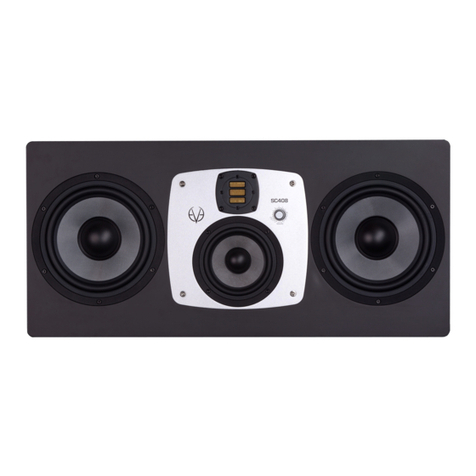
Eve Audio
Eve Audio SC407 User manual
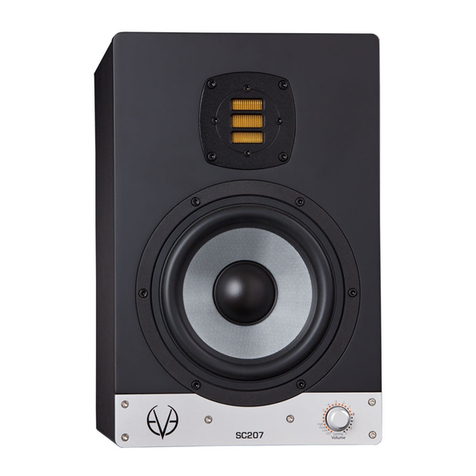
Eve Audio
Eve Audio SC207 User manual

Eve Audio
Eve Audio SC Series User manual
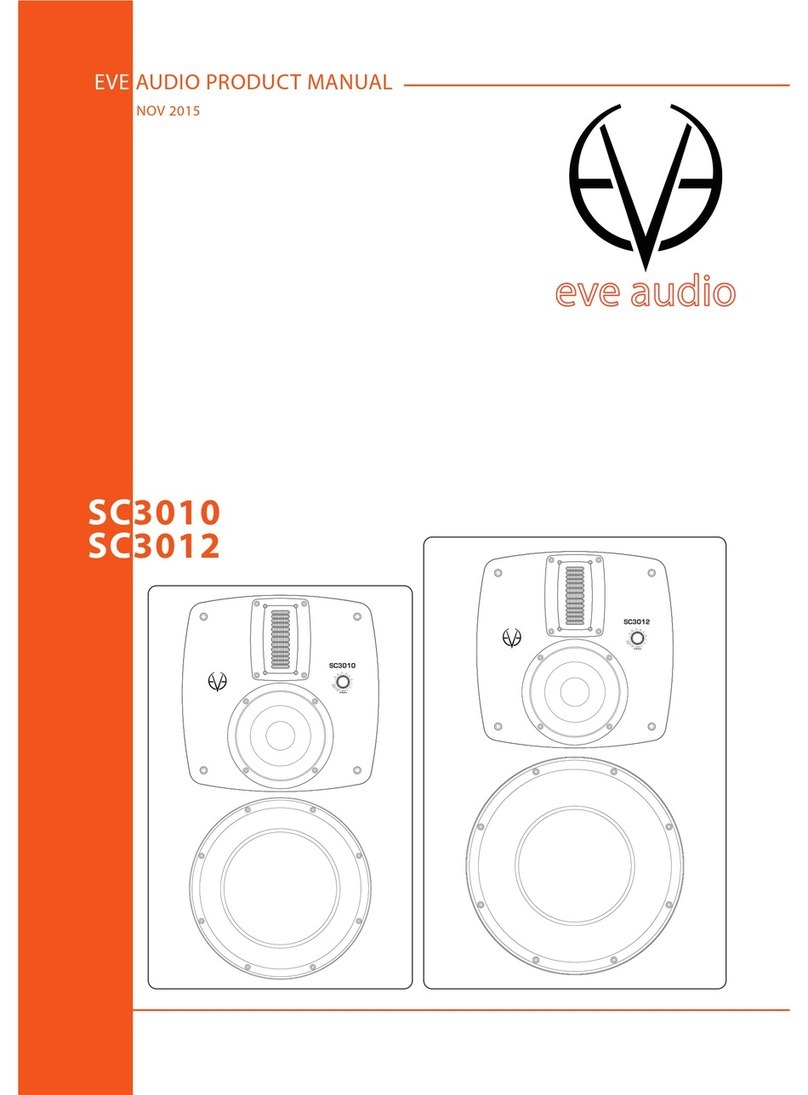
Eve Audio
Eve Audio sc3010 User manual

Eve Audio
Eve Audio SC4070 User manual

Eve Audio
Eve Audio SC204 User manual

Eve Audio
Eve Audio SC305 User manual
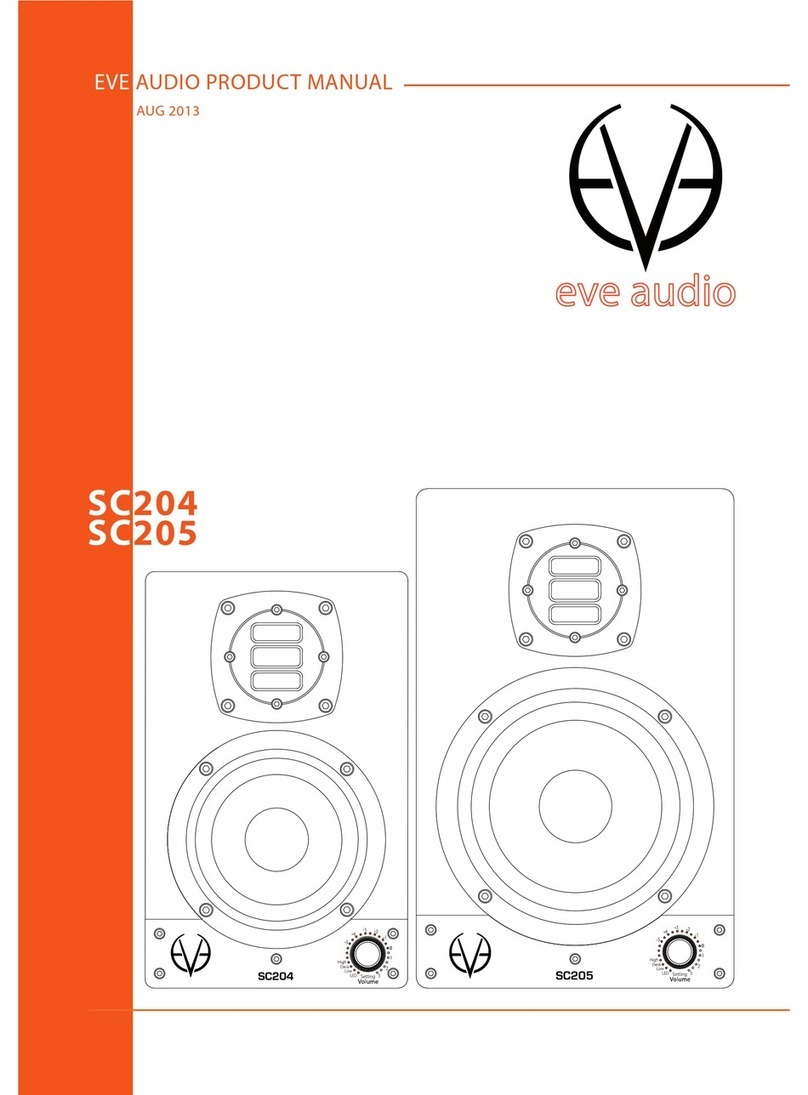
Eve Audio
Eve Audio SC204 User manual
